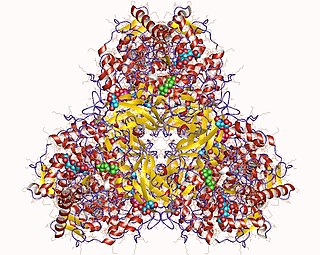
β-Amylase is an enzyme with the systematic name 4-α-D-glucan maltohydrolase. It catalyses the following reaction:

Benzylamine is an organic chemical compound with the condensed structural formula C6H5CH2NH2 (sometimes abbreviated as PhCH2NH2 or BnNH2). It consists of a benzyl group, C6H5CH2, attached to an amine functional group, NH2. This colorless water-soluble liquid is a common precursor in organic chemistry and used in the industrial production of many pharmaceuticals. The hydrochloride salt was used to treat motion sickness on the Mercury-Atlas 6 mission in which NASA astronaut John Glenn became the first American to orbit the Earth.

Fumarylacetoacetase is an enzyme that in humans is encoded by the FAH gene located on chromosome 15. The enzyme is involved in the catabolism of the amino acid tyrosine in humans.

Glucan 1,4-α-glucosidase is an enzyme located on the brush border of the small intestine with systematic name 4-α-D-glucan glucohydrolase. It catalyses the following chemical reaction

In enzymology, a microsomal epoxide hydrolase (mEH) is an enzyme that catalyzes the hydrolysis reaction between an epoxide and water to form a diol.
A ureohydrolase is a type of hydrolase enzyme. The ureohydrolase superfamily includes arginase, agmatinase, formiminoglutamase and proclavaminate amidinohydrolase. These enzymes share a 3-layer alpha-beta-alpha structure, and play important roles in arginine/agmatine metabolism, the urea cycle, histidine degradation, and other pathways.
In molecular biology, glycoside hydrolase family 15 is a family of glycoside hydrolases.

The haloacid dehydrogenase superfamily is a superfamily of enzymes that include phosphatases, phosphonatases, P-type ATPases, beta-phosphoglucomutases, phosphomannomutases, and dehalogenases, and are involved in a variety of cellular processes ranging from amino acid biosynthesis to detoxification.
Enzyme promiscuity is the ability of an enzyme to catalyze an unexpected side reaction in addition to its main reaction. Although enzymes are remarkably specific catalysts, they can often perform side reactions in addition to their main, native catalytic activity. These wild activities are usually slow relative to the main activity and are under neutral selection. Despite ordinarily being physiologically irrelevant, under new selective pressures, these activities may confer a fitness benefit therefore prompting the evolution of the formerly promiscuous activity to become the new main activity. An example of this is the atrazine chlorohydrolase from Pseudomonas sp. ADP evolved from melamine deaminase, which has very small promiscuous activity toward atrazine, a man-made chemical.
Cannabidiolic acid synthase is an enzyme with systematic name cannabigerolate:oxygen oxidoreductase . It is an oxidoreductase found in Cannabis sativa that catalyses the formation of cannabidiolate, a carboxylated precursor of cannabidiol.
Endo-α-N-acetylgalactosaminidase (EC 3.2.1.97, endo-α-acetylgalactosaminidase, endo-α-N-acetyl-D-galactosaminidase, mucinaminylserine mucinaminidase, D-galactosyl-3-(N-acetyl-α-D-galactosaminyl)-L-serine mucinaminohydrolase, endo-α-GalNAc-ase, D-galactosyl-N-acetyl-α-D-galactosamine D-galactosyl-N-acetyl-galactosaminohydrolase) is an enzyme with systematic name glycopeptide-D-galactosyl-N-acetyl-α-D-galactosamine D-galactosyl-N-acetyl-galactosaminohydrolase. This enzyme catalyses the following chemical reaction
Beta-D-glucopyranosyl abscisate beta-glucosidase (EC 3.2.1.175, AtBG1, ABA-beta-D-glucosidase, ABA-specific beta-glucosidase, ABA-GE hydrolase, beta-D-glucopyranosyl abscisate hydrolase) is an enzyme with systematic name beta-D-glucopyranosyl abscisate glucohydrolase. This enzyme catalyses the following chemical reaction
Gellan tetrasaccharide unsaturated glucuronyl hydrolase (EC 3.2.1.179, UGL, unsaturated glucuronyl hydrolase) is an enzyme with systematic name beta-D-4-deoxy-Delta4-GlcAp-(1->4)-beta-D-Glcp-(1->4)-alpha-L-Rhap-(1->3)-beta-D-Glcp beta-D-4-deoxy-Delta4-GlcAp hydrolase. This enzyme catalyses the following chemical reaction
Unsaturated chondroitin disaccharide hydrolase (EC 3.2.1.180, UGL, unsaturated glucuronyl hydrolase) is an enzyme with systematic name beta-D-4-deoxy-Delta4-GlcAp-(1->3)-beta-D-GalNAc6S hydrolase. This enzyme catalyses the following chemical reaction

(ADP-ribosyl)hydrolase 1, also termed [Protein ADP-ribosylarginine] hydrolase and protein-Nω-(ADP-D-ribosyl)-L-arginine ADP-ribosylhydrolase (EC 3.2.2.19), is an enzyme that in humans is encoded by the ADPRH gene. This enzyme is a specific mono(ADP-ribosyl)hydrolase that catalyses the removal of an ADP-ribosyl modification from target arginine residues of protein substrates. The chemical reactions can formally be described as follows:
Acylaminoacyl-peptidase is an enzyme. This enzyme catalyses the following chemical reaction
UDP-2,4-diacetamido-2,4,6-trideoxy-beta-L-altropyranose hydrolase (EC 3.6.1.57, PseG, UDP-6-deoxy-AltdiNAc hydrolase, Cj1312) is an enzyme with systematic name UDP-2,4-bis(acetamido)-2,4,6-trideoxy-beta-L-altropyranose hydrolase. This enzyme catalyses the following chemical reaction
4,5:9,10-diseco-3-hydroxy-5,9,17-trioxoandrosta-1(10),2-diene-4-oate hydrolase (EC 3.7.1.17, tesD (gene), hsaD (gene)) is an enzyme with systematic name 4,5:9,10-diseco-3-hydroxy-5,9,17-trioxoandrosta-1(10),2-diene-4-oate hydrolase ( (2Z,4Z)-2-hydroxyhexa-2,4-dienoate-forming). This enzyme catalyses the following chemical reaction
Terpentetriene synthase is an enzyme with systematic name terpentedienyl-diphosphate diphosphate-lyase (terpentetriene-forming). This enzyme catalyses the following chemical reaction
Terpentedienyl-diphosphate synthase is an enzyme with systematic name terpentedienyl-diphosphate lyase (decyclizing). This enzyme catalyses the following chemical reaction







